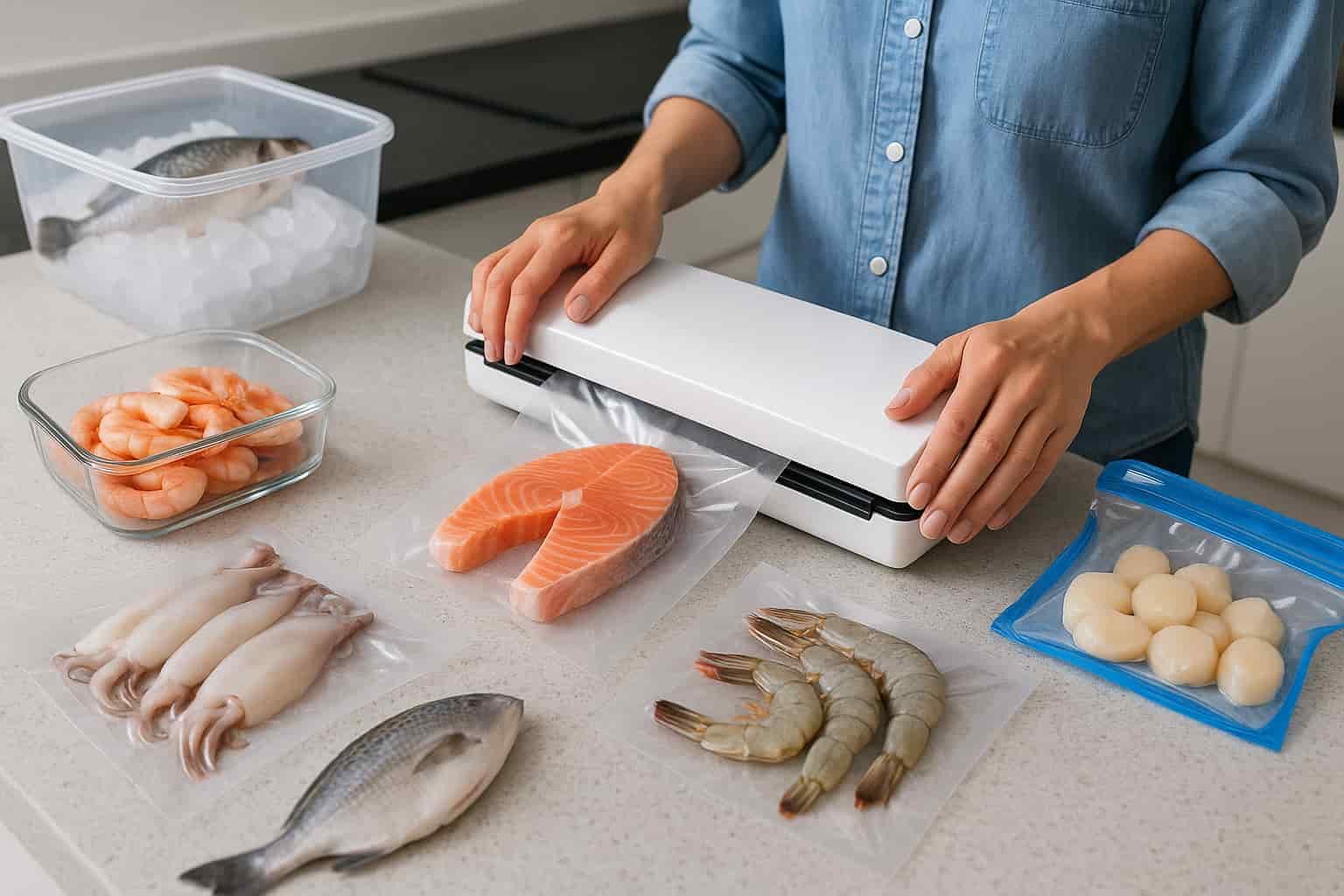Seafood is a highly perishable food category that requires careful handling to preserve its quality and ensure safety. Improper storage can lead to bacterial growth, unpleasant odors, and, more importantly, foodborne illnesses. Whether you’re a home cook planning to store your market haul or a seafood lover stocking up for future meals, understanding how to store and freeze seafood properly is essential.
This guide will walk you through the best practices for keeping both raw and cooked seafood fresh, safe, and delicious. From optimal fridge and freezer temperatures to safe thawing methods, you’ll find comprehensive insights to extend the shelf life of your seafood without compromising taste or texture.
Contents
- 1 Understanding Seafood Spoilage
- 2 General Rules for Storing Fresh Seafood in the Fridge
- 3 Best Practices for Freezing Raw Seafood
- 4 How to Freeze Cooked Seafood
- 5 How Long Can You Freeze Seafood?
- 6 Thawing Seafood Safely
- 7 Storage Containers and Equipment Recommendations
- 8 Common Mistakes to Avoid When Storing Seafood
- 9 Tips for Buying Seafood That Freezes Well
- 10 Conclusion
- 11 Frequently Asked Questions (FAQ)
Understanding Seafood Spoilage
Seafood begins to deteriorate quickly after it’s harvested, far faster than most land-based meats. The high water content and the natural enzymes present in fish and shellfish make them particularly vulnerable to spoilage. Additionally, many species of seafood thrive in cold environments, so even slight temperature increases can accelerate bacterial growth once they’re out of their natural habitat.
Common signs of spoiled seafood include a strong ammonia-like smell, slimy or mushy texture, and dull or discolored flesh. For shellfish like mussels or clams, an open shell that doesn’t close when tapped is a clear indicator that the shellfish is no longer alive and should be discarded.
Understanding these spoilage indicators is the first step in handling seafood responsibly. It helps you avoid health risks and minimizes food waste.
General Rules for Storing Fresh Seafood in the Fridge
Storing seafood in the refrigerator requires close attention to temperature, packaging, and shelf placement. The ideal refrigerator temperature for fresh seafood is 32°F (0°C)—colder than the average home fridge. If your fridge doesn’t maintain this low temperature, consider using a container filled with crushed ice to keep your seafood chilled.
Here are essential tips for fridge storage:
- Use leak-proof containers or trays lined with paper towels to absorb excess moisture.
- Keep seafood in its original packaging if it’s vacuum-sealed or rewrap it tightly in plastic wrap and aluminum foil.
- Store it on the bottom shelf, away from ready-to-eat foods to prevent cross-contamination.
- Check seafood daily, and if you don’t plan to cook it within 1–2 days (for fish) or 1–3 days (for shellfish), freezing is the safer option.
If you’re unsure how to select high-quality raw seafood in the first place, refer to our guide on How to Choose Sashimi-Grade Seafood to make informed buying decisions.
Best Practices for Freezing Raw Seafood
Freezing is one of the most effective ways to extend the shelf life of seafood without compromising too much on flavor or texture. However, improper freezing techniques can lead to freezer burn, texture degradation, and reduced nutritional value. To ensure the best results, it’s crucial to prepare raw seafood properly before freezing.
Start by cleaning and drying the seafood thoroughly. Excess moisture leads to ice crystals, which can damage the cellular structure of the fish or shellfish during freezing. Next, wrap the seafood tightly in plastic wrap or parchment paper, followed by a layer of aluminum foil or place it in an airtight freezer-safe bag or vacuum-sealed pouch. Removing as much air as possible will help prevent oxidation and freezer burn.
For best results:
- Freeze seafood at 0°F (-18°C) or lower.
- Label packages with the type of seafood and the date of freezing.
- Avoid freezing seafood that has been previously frozen and thawed, unless it was cooked in between.
By following these best practices, you can maintain the quality and safety of your raw seafood for several months.
How to Freeze Cooked Seafood
Freezing cooked seafood is a convenient way to preserve leftovers or prepare meals in advance. While not all cooked seafood freezes equally well, many types—such as baked salmon, cooked shrimp, or crab cakes—can retain their flavor and texture when stored properly.
Begin by allowing the cooked seafood to cool completely at room temperature (no more than 1 hour). Place the portions in airtight containers or wrap them tightly using freezer wrap and aluminum foil to prevent exposure to air. As with raw seafood, labeling is essential to keep track of storage duration.
Key tips for freezing cooked seafood:
- Divide into portion sizes to minimize thawing and refreezing.
- Avoid creamy or dairy-based seafood dishes, as these tend to separate or curdle when thawed.
- Freeze within 2 hours of cooking to prevent bacterial growth.
- Most cooked seafood dishes can be kept frozen for 2 to 3 months without significant quality loss.
Proper packaging and storage practices help preserve the taste and reduce the risk of contamination when you’re ready to reheat and enjoy your cooked seafood.
How Long Can You Freeze Seafood?
Knowing how long you can safely freeze seafood is key to avoiding waste and maintaining food safety. While freezing does not kill bacteria, it does put them in a dormant state. However, over time, the quality of seafood will degrade, even in the freezer.
Here is a general guideline for maximum recommended freezing durations:
- Fatty fish (like salmon, mackerel): up to 2–3 months
- Lean fish (like cod, haddock): up to 6 months
- Shrimp, scallops, squid: up to 3–6 months
- Cooked seafood: ideally consumed within 2–3 months
- Lobster and crab (cooked or raw): 2–4 months
Always ensure seafood is stored at or below 0°F (-18°C). Additionally, packaging should be secure and moisture-resistant to avoid freezer burn, which can negatively affect flavor and texture.
While seafood may technically remain safe beyond these timeframes, the quality will decline significantly, making it less enjoyable to eat.
Thawing Seafood Safely
Thawing seafood properly is just as important as how you store or freeze it. Unsafe thawing methods can lead to rapid bacterial growth, increasing the risk of foodborne illness. To ensure both safety and quality, it’s essential to follow approved thawing techniques.
The safest method is to thaw seafood in the refrigerator. This process may take several hours or overnight, depending on the size and thickness of the seafood. It keeps the seafood at a safe, consistent temperature and prevents bacteria from multiplying.
Alternative safe methods include:
- Cold water thawing: Place the seafood in a leak-proof plastic bag and submerge it in cold water. Change the water every 30 minutes. This method is faster than fridge thawing but still safe.
- Microwave thawing: Suitable only when the seafood will be cooked immediately after. Uneven thawing may occur, so it’s not ideal for delicate items.
Never thaw seafood at room temperature or under warm water. These practices expose the food to the “danger zone” (40°F–140°F / 4°C–60°C), where bacteria multiply rapidly. Once thawed, seafood should be cooked within 24 hours and should never be refrozen raw.
Storage Containers and Equipment Recommendations
Choosing the right storage tools is crucial for maximizing seafood freshness, especially when freezing for extended periods. Improper containers or sealing methods can lead to freezer burn, off-flavors, or contamination.
Here are some recommended storage solutions:
- Vacuum sealers: These provide the best long-term protection by removing air, which prevents oxidation and ice crystal formation.
- Freezer-safe plastic bags: Choose heavy-duty, BPA-free bags designed for low temperatures. Press out as much air as possible before sealing.
- Airtight containers: Ideal for cooked seafood or marinated items. Opt for glass or BPA-free plastic containers with a tight seal.
- Aluminum foil and plastic wrap combo: When used together, they create a strong barrier against moisture loss and freezer odors.
Additional tools that help with seafood storage:
- Refrigerator/freezer thermometers: Ensure storage temperatures remain safe.
- Labels and markers: Help track freezing dates and seafood types.
- Ice packs or insulated trays: Useful when transporting fresh seafood from the market or storing temporarily in the fridge.
Investing in the right equipment not only protects the quality of your seafood but also enhances food safety and convenience.
Common Mistakes to Avoid When Storing Seafood
Even with the best intentions, many people unknowingly make storage mistakes that compromise seafood quality and safety. Avoiding these errors is key to maintaining freshness and preventing spoilage.
Here are some common pitfalls:
- Failing to monitor temperature: Seafood must be kept cold at all times. A refrigerator that fluctuates above 40°F (4°C) or a freezer warmer than 0°F (-18°C) can shorten shelf life significantly.
- Freezing seafood with excess moisture: Water left on the surface can form ice crystals that damage texture and taste.
- Improper wrapping: Loose packaging allows air in, causing freezer burn. Always wrap tightly and double-layer when necessary.
- Neglecting to label packages: Without proper labeling, it’s easy to lose track of how long an item has been stored, increasing the risk of consuming expired products.
- Storing seafood near strong-smelling items: Seafood can absorb odors easily, so keep it away from foods like onions, garlic, or pungent cheeses.
Being mindful of these mistakes can help you preserve seafood safely, reduce waste, and enjoy the best possible flavor and texture every time you cook.
Tips for Buying Seafood That Freezes Well
Proper storage begins at the point of purchase. Choosing seafood that’s suitable for freezing helps preserve texture, flavor, and safety over the long term. Whether you’re buying from a supermarket, fishmonger, or local market, being selective about what you buy makes all the difference.
Here are some useful tips:
- Opt for flash-frozen or previously frozen seafood if you’re not planning to consume it right away. Flash-frozen fish are often frozen at sea, preserving peak freshness.
- Choose firm, high-quality fish such as cod, halibut, salmon, or tilapia for freezing. These varieties tend to withstand freezing better than more delicate species.
- Shellfish with shells on (e.g., shrimp, clams, mussels) tend to freeze better than shelled ones, as the shell offers natural protection from freezer damage.
- Avoid seafood that smells overly fishy or has dull, discolored flesh—it may already be near the end of its freshness window.
- Buy in bulk only if you plan to freeze portions immediately. Always transport seafood in insulated containers or with ice if there will be delays before refrigerating or freezing.
By making smart purchasing decisions, you can improve storage outcomes and ensure consistent quality from freezer to plate.
Conclusion
Storing and freezing seafood safely is an essential skill for anyone who enjoys cooking with ocean-fresh ingredients. From selecting high-quality fish at the market to following proper refrigeration, freezing, and thawing methods at home, every step plays a role in preserving flavor and preventing foodborne illness.
By applying the best practices outlined in this guide—such as maintaining safe temperatures, using appropriate containers, labeling accurately, and avoiding common mistakes—you’ll be able to extend the shelf life of both raw and cooked seafood without sacrificing taste or texture.
Whether you’re a busy home cook prepping for the week or someone who buys seafood in bulk, these techniques help you enjoy delicious, safe, and sustainable meals with confidence.
Frequently Asked Questions (FAQ)
Can I refreeze seafood after it has been thawed?
Only if it was thawed safely in the refrigerator and has not reached room temperature. However, note that quality may decline with each freeze-thaw cycle.
What’s the best container to freeze shrimp in?
Vacuum-sealed bags are ideal. Otherwise, use freezer-safe ziplock bags, tightly sealed, with as much air removed as possible.
How long can fresh fish stay in the fridge before freezing?
Ideally no more than 1–2 days. If you’re not planning to cook it within that time, freezing is recommended.
Is it safe to eat seafood left out overnight?
No. Seafood should never be left at room temperature for more than 1–2 hours. Bacteria can grow rapidly and make it unsafe to eat.
How can I prevent freezer burn on seafood?
Use airtight packaging (preferably vacuum-sealed), remove excess air, wrap tightly, and store seafood at 0°F (-18°C) or below.



